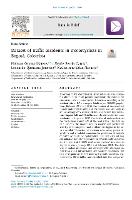Abstract
According to the World Health Organization, in 2016, Colombia obtained the tenth position worldwide, the third in the continent and the second in South America, according to the accident rate of 9.7 motorcycle fatalities per 100,000 populations. Between 2012 and 2021, the number of deceased and injured motorcyclists among all road users was 50%, with an annual average of 3140 fatal victims and 20,800 injured victims. Bogotá, Cali, and Medellín were the cities with the most accidents. In Bogota in 2017, the deaths of motorcyclists on the roads were around 32% of the road actors. This data article presents the dataset used to analyze and predict the severity of motorcyclist road accidents in Bogota in the article entitled “Extraction of decision rules using genetic algorithms and simulated annealing for prediction of severity of traffic accidents by motorcyclists” [1]. The data set was consolidated from the registration of 175,245 traffic accidents and the report of 337,828 road actors involved in crashes in Bogotá between January 2013 and February 2018. The data was compiled, processed, and enriched with additional information about infrastructure and weather conditions. The data corresponds to 35,693 motorcyclist traffic accidents, represented by 28 variables, and classified into five categories: road actors, motorcyclists and individuals involved, weather conditions and timing, road conditions and location and characteristics of the accident. The data on motorcyclist traffic accidents opens up a scenario to deepen and compare road safety in Latin America, where studies on vulnerable road users are limited. According to severity, the data on motorcycle traffic accidents recorded 28% with material damage, 69% with injured and 3% with fatal victims














